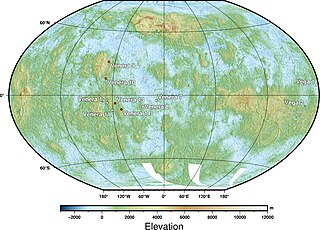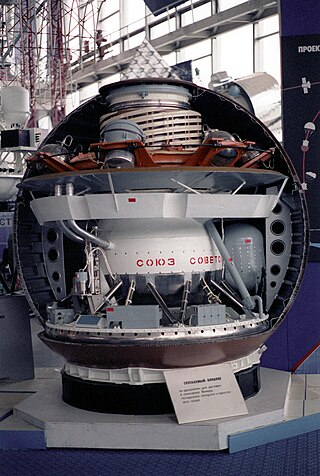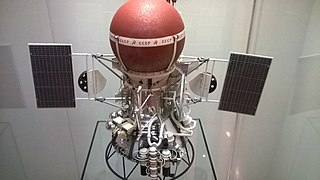Related Research Articles

The Mariner program was conducted by the American space agency NASA to explore other planets. Between 1962 and late 1973, NASA's Jet Propulsion Laboratory (JPL) designed and built 10 robotic interplanetary probes named Mariner to explore the inner Solar System – visiting the planets Venus, Mars and Mercury for the first time, and returning to Venus and Mars for additional close observations.

The Venera program was a series of space probes developed by the Soviet Union between 1961 and 1984 to gather information about the planet Venus.

The Pioneer Venus project was part of the Pioneer program consisting of two spacecraft, the Pioneer Venus Orbiter and the Pioneer Venus Multiprobe, launched to Venus in 1978. The program was managed by NASA's Ames Research Center.

Giotto was a European robotic spacecraft mission from the European Space Agency. The spacecraft flew by and studied Halley's Comet and in doing so became the first spacecraft to make close up observations of a comet. On 13 March 1986, the spacecraft succeeded in approaching Halley's nucleus at a distance of 596 kilometers. It was named after the Early Italian Renaissance painter Giotto di Bondone. He had observed Halley's Comet in 1301 and was inspired to depict it as the star of Bethlehem in his painting Adoration of the Magi in the Scrovegni Chapel.

Vega 1 was a Soviet space probe, part of the Vega program. The spacecraft was a development of the earlier Venera craft. They were designed by Babakin Space Centre and constructed as 5VK by Lavochkin at Khimki. The name VeGa (ВеГа) combines the first two letters from the Russian words for Venus and Halley.

The Vega program was a series of Venus missions that also took advantage of the appearance of comet 1P/Halley in 1986. Vega 1 and Vega 2 were uncrewed spacecraft launched in a cooperative effort among the Soviet Union and Austria, Bulgaria, France, Hungary, the German Democratic Republic, Poland, Czechoslovakia, and the Federal Republic of Germany in December 1984. They had a two-part mission to investigate Venus and also flyby Halley's Comet.

Venera 16 was a spacecraft sent to Venus by the Soviet Union. This uncrewed orbiter was to map the surface of Venus using high resolution imaging systems. The spacecraft was identical to Venera 15 and based on modifications to the earlier Venera space probes. The latest data from the spacecraft were received on June 13, 1985, when it responded to the signal sent from Earth for Vega 1.

The Venera 11 was a Soviet uncrewed space mission which was part of the Venera program to explore the planet Venus. Venera 11 was launched on 9 September 1978 at 03:25:39 UTC.

The Venera 12 was an uncrewed Soviet space mission designed to explore the planet Venus. Venera 12 was launched on 14 September 1978 at 02:25:13 UTC.

Venera 9, manufacturer's designation: 4V-1 No. 660, was a Soviet uncrewed space mission to Venus. It consisted of an orbiter and a lander. It was launched on June 8, 1975, at 02:38:00 UTC and had a mass of 4,936 kilograms (10,882 lb). The orbiter was the first spacecraft to orbit Venus, while the lander was the first to return images from the surface of another planet.

Venera 10, or 4V-1 No. 661, was a Soviet uncrewed space mission to Venus. It consisted of an orbiter and a lander. It was launched on June 14, 1975, 03:00:31 UTC and had a mass of 5033 kg (11096 lb).

Venera 6, or 2V (V-69) No.331, was a Soviet spacecraft, launched towards Venus to obtain atmospheric data. It had an on-orbit dry mass of 1,130 kg (2,490 lb).

The Comet Rendezvous Asteroid Flyby (CRAF) was a cancelled plan for a NASA-led exploratory mission designed by the Jet Propulsion Laboratory during the mid-to-late 1980s and early 1990s, that planned to send a spacecraft to encounter an asteroid, and then to rendezvous with a comet and fly alongside it for nearly three years. The project was eventually canceled when it went over budget; most of the money still left was redirected to its twin spacecraft, Cassini–Huygens, destined for Saturn, so it could survive Congressional budget cutbacks. Most of CRAF's scientific objectives were later accomplished by the smaller NASA spacecraft Stardust and Deep Impact, and by ESA's flagship Rosetta mission.

Venera 4, also designated 4V-1 No.310, was a probe in the Soviet Venera program for the exploration of Venus. The probe comprised a lander, designed to enter the Venusian atmosphere and parachute to the surface, and a carrier/flyby spacecraft, which carried the lander to Venus and served as a communications relay for it.

Venera 8 was a probe in the Soviet Venera program for the exploration of Venus and was the second robotic space probe to conduct a successful landing on the surface of Venus.

Venera 13 was part of the Soviet Venera program meant to explore Venus.

Venera 14 was a probe in the Soviet Venera program for the exploration of Venus.

Observations of the planet Venus include those in antiquity, telescopic observations, and from visiting spacecraft. Spacecraft have performed various flybys, orbits, and landings on Venus, including balloon probes that floated in the atmosphere of Venus. Study of the planet is aided by its relatively close proximity to the Earth, compared to other planets, but the surface of Venus is obscured by an atmosphere opaque to visible light.

Venera-D is a proposed Russian space mission to Venus that would include an orbiter and a lander to be launched in 2031. The orbiter's prime objective is to perform observations with the use of a radar. The lander, based on the Venera design, would be capable of operating for a long duration on the planet's surface. The "D" in Venera-D stands for "dolgozhivuschaya," which means "long lasting" in Russian.
References
- 1 2 3 Asif Siddiqi (2018). Beyond Earth: A Chronicle of Deep Space Exploration, 1958–2016 (PDF) (second ed.). NASA History Program Office. ISBN 978-1-626-83043-1.
- 1 2 "Vega 2". nssdc.gsfc.nasa.gov. NASA . Retrieved 22 July 2024.
- 1 2 "In Depth: Vega 2". solarsystem.nasa.gov. NASA . Retrieved 14 April 2015.
- 1 2 3 4 Paolo Ulivi; David M. Harland (2009). Robotic Exploration of the Solar System Part II: Hiatus and Renewal. Springer. pp. 90–92. ISBN 978-0-387-78904-0.
External links
- Vega 2 Measuring Mission Profile by NASA's Solar System Exploration
- Vega mission images from the Space Research Institute (IKI)
- Raw data from Vega 1 and Vega 2 on board instruments
- Soviet Exploration of Venus
- Vega 2 Mission Comet Halley Data Archive at the NASA Planetary Data System, Small Bodies Node
 A replica of the Vega spacecraft displayed at the Udvar-Hazy Center, Virginia, US | |
| Names | Venera–Halley 2 |
|---|---|
| Mission type | Venus/Halley exploration |
| Operator | Soviet space program |
| COSPAR ID | 1984-128A 1984-128E 1984-128F |
| SATCAT no. | 15449 15856 15857 |
| Mission duration | Lander: 56 minutes Balloon: 2 days Flyby: 2 years, 3 months and 3 days |
| Spacecraft properties | |
| Spacecraft | 5VK No. 902 |
| Spacecraft type | 5VK |
| Manufacturer | NPO Lavochkin |
| Launch mass | 4,840 kg (10,670 lb) [1] |
| Landing mass | 1,520 kg (3,350 lb) |
| Dimensions | 2.7 m × 2.3 m × 5.7 m (8.9 ft × 7.5 ft × 18.7 ft) (lander) |
| Start of mission | |
| Launch date | December 21, 1984, 09:13:52 UTC [1] |
| Rocket | Proton-K/D |
| Launch site | Baikonur 200/40 |
| Contractor | Khrunichev |
| End of mission | |
| Last contact | March 24, 1987 [1] |
| Orbital parameters | |
| Reference system | Heliocentric |
| Eccentricity | 0.17 |
| Perihelion altitude | 0.70 AU |
| Aphelion altitude | 0.98 AU |
| Inclination | 51.5° |
| Period | 281 days |
| Flyby of Venus | |
| Closest approach | June 15, 1985 |
| Distance | 24,500 km (15,200 mi) |
| Active missions |
| ||||||||||||
|---|---|---|---|---|---|---|---|---|---|---|---|---|---|
| Past missions |
| ||||||||||||
| Planned missions |
| ||||||||||||
| Proposed missions |
| ||||||||||||
| Cancelled or not developed | |||||||||||||
| Program overviews | |||||||||||||
| Related | |||||||||||||
| |||||||||||||






